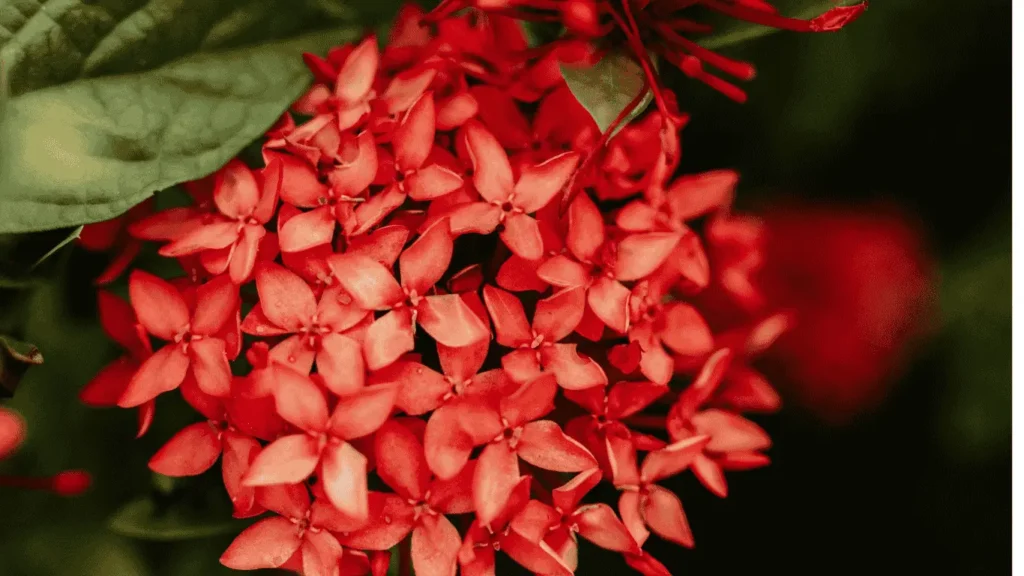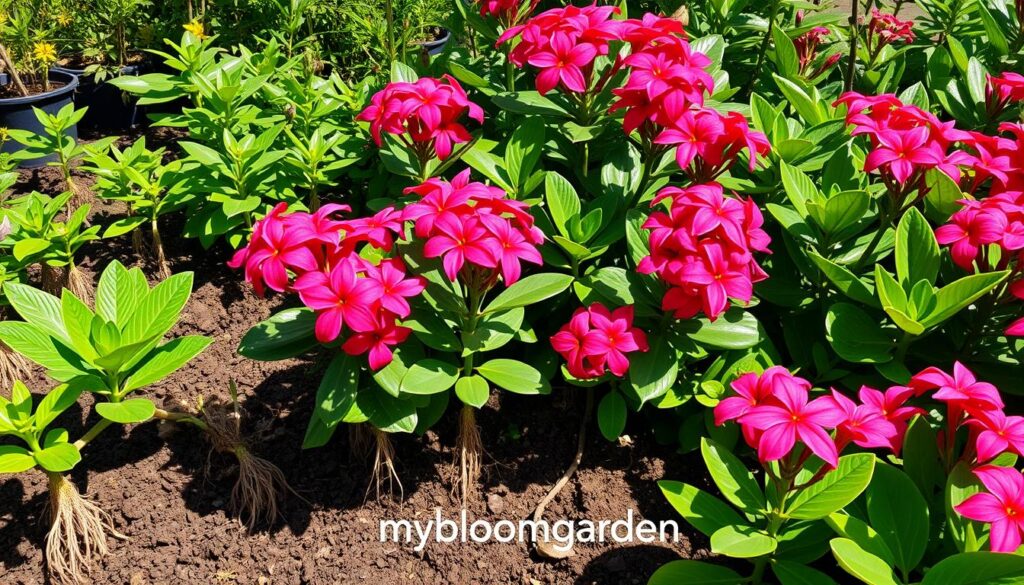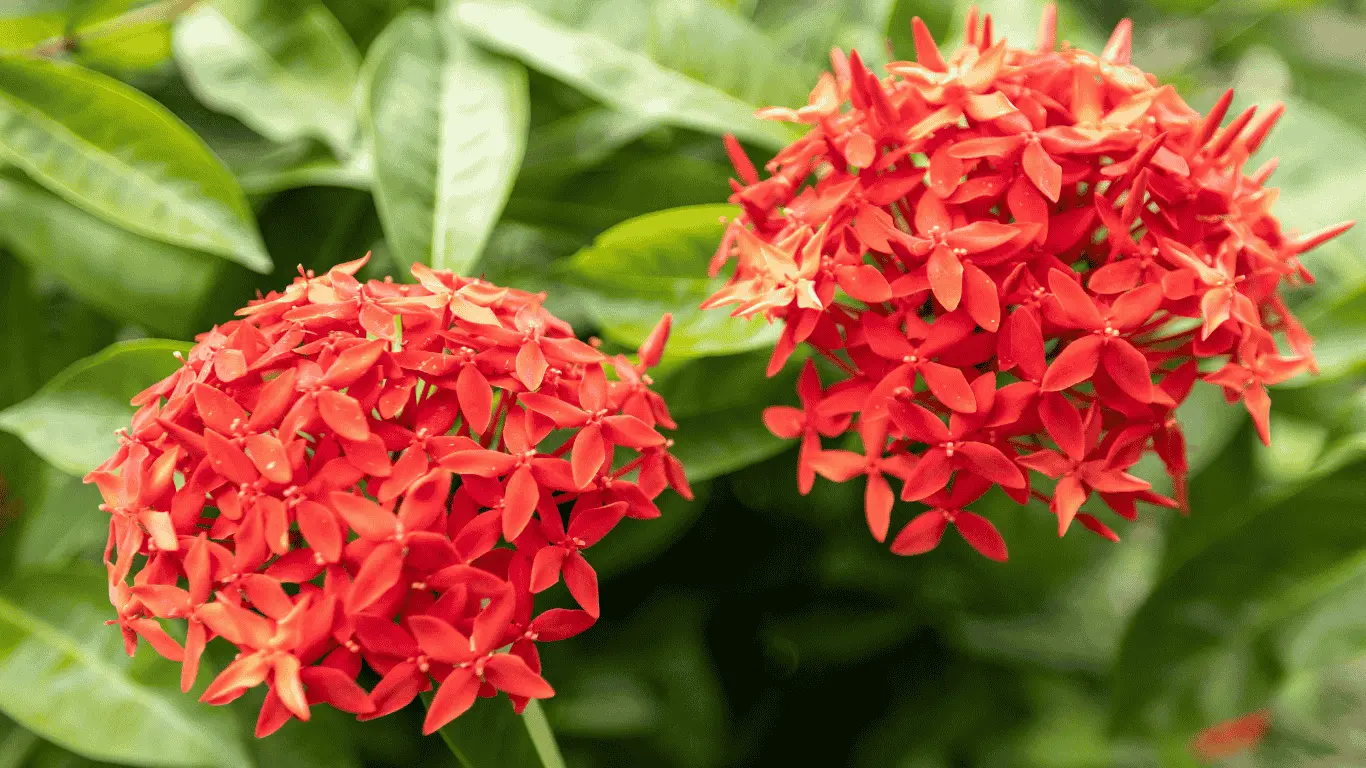As the warm summer breeze touches your face, you can’t help but be drawn to the vibrant blooms in your garden. These are not just any flowers. They are the enchanting ixora plants, known for their stunning colors and ability to make any outdoor space lush and inviting.
Ixora plants are loved for their exotic beauty, versatility, and ability to thrive in tough conditions. Whether you’re an experienced gardener or just starting out, these shrubs will surely win your heart. With a long history and many varieties, ixora plants offer a special and rewarding experience for those who want to make their outdoor spaces more beautiful.
Table of Contents
Understanding the Exotic Ixora Plant Species
The ixora plant is a captivating evergreen shrub found in tropical and subtropical areas around the world. Its vibrant blooms and striking foliage have won the hearts of many gardeners and plant lovers. Learning about its natural habitats and growth patterns helps us understand its unique traits and how to care for it.
Native Habitats and Natural Growth Patterns
The ixora plant comes from Asia and parts of Africa. It loves warm, humid climates. In the wild, it grows in moist, well-drained soil and shaded areas. It has lush foliage and vibrant flowers that attract many pollinators.
Common Varieties and Their Characteristics
- Ixora coccinea: This classic ixora plant variety is known for its stunning red or orange blooms and glossy, deep green leaves.
- Ixora chinensis: Commonly referred to as the Chinese ixora shrub, this species boasts clusters of delicate, pastel-colored flowers in shades of pink, white, and yellow.
- Ixora finlaysoniana: The Finlayson’s ixora plant is prized for its unique, copper-toned foliage and showy, multicolored flower heads.
Botanical Classification and Features
The ixora plant is part of the Rubiaceae family, which includes many flowering shrubs and trees. These exotic plants have opposite, leathery leaves and tubular flowers in vibrant clusters. Their flowers come in a variety of colors, making them perfect for any garden or landscaping project.
The Rainbow Spectrum of Ixora Colors
The ixora plant, also known as the “red bush ixora,” is a vibrant addition to any garden. It comes in a range of colors, from the bold ixora red to the soft ixora yellow. This shrub offers a variety of shades to match any garden style.
The fiery red ixora is a standout with its bold, cup-shaped blooms. These red bush ixora plants are perfect for adding drama to your garden. Meanwhile, the ixora yellow cultivars add a soft elegance with their sunny hues.
Ixora plants also come in orange, pink, and white. These ixora colors let gardeners create stunning combinations. They can match any personal style or garden design.
“The ixora plant is a true chameleon, offering a rainbow of options to suit any gardener’s taste.”
Whether you prefer bold or soft colors, ixora plants have something for everyone. Their vibrant blooms can turn any outdoor space into a colorful oasis.
Growing and Maintaining Healthy Ixora Bushes
To grow lush ixora bushes, you need to focus on soil, water, and fertilizer. Knowing what these plants need helps them thrive in your garden.
Soil Requirements and pH Levels
Ixora bushes love acidic soil with a pH of 5.0 to 6.5. The soil should be rich in compost or peat moss. This improves drainage and gives nutrients. Heavy clay soils can cause waterlogging and root rot.
Watering Schedule and Humidity Needs
- Keep the soil of ixora plants moist but not too wet. Water them regularly.
- They also need high humidity. You can increase it by misting leaves or using a pebble tray.
Fertilization Tips for Optimal Growth
Use a slow-release fertilizer made for acid-loving plants. Feed them every 4-6 weeks during the growing season. Follow the instructions on the fertilizer package. Too much fertilizer can harm the blooms.
By taking care of the soil, water, and fertilizer needs, your ixora bushes will bloom beautifully. This will make your garden vibrant and stunning.
Ixora Flowers: Creating Stunning Garden Displays
Bring the vibrant beauty of the ixora flower plant to your garden. Turn it into a lush, colorful oasis. These blooms are perfect for any outdoor space, making a striking visual impact.
To create a stunning garden display with ixora shrubs, consider the following tips:
- Use the ixora’s diverse color range. From fiery reds and oranges to soft pinks and yellows, the ixora’s blooms come in a spectrum of hues. You can strategically incorporate them to enhance your garden’s aesthetic.
- Group ixora plants together for maximum impact. Clustering these vibrant shrubs creates a cohesive, eye-catching focal point. It will draw the eye and captivate visitors.
- Pair ixora with complementary plants. Enhance the ixora’s beauty by combining it with plants that share a similar color palette or provide a contrasting texture. This could be lush green foliage or delicate flowering perennials.
- Incorporate ixora into container gardens. These versatile plants thrive in both in-ground and potted settings. They’re an excellent choice for adding pops of color to patios, balconies, or entryways.
With their striking appearance and diverse growth habits, ixora flowers can transform any garden into a true haven of color and beauty. Embrace the ixora’s charm and let your outdoor space bloom with the essence of the tropics.

“The ixora flower is a true garden gem, adding a vibrant and tropical flair to any outdoor space.”
Seasonal Care Guide for Ixora Plant Success
To keep your ixora plants looking their best, you need to care for them seasonally. As the weather changes, so should your ixora plant care methods. This ensures these tropical flowers bloom well in your garden.
Spring and Summer Maintenance
In spring and summer, ixora plants love the warmth and sun. To keep them happy, remember to:
- Water them often to keep the soil moist but not too wet
- Feed them a balanced fertilizer to help them grow strong and bloom
- Prune them to keep their shape and encourage new growth
Fall and Winter Protection Strategies
When it gets colder, ixora plants need more care to make it through the winter. To help them, make sure to:
- Water them less to avoid root rot
- Wrap insulation around the base to protect the roots
- Move potted plants to a sunny, sheltered spot or bring them inside
Pruning and Shaping Guidelines
Pruning is key to keeping your ixora plants healthy and looking good. Prune in early spring, cutting off any dead or damaged parts. This will help your plant grow lush and full, ready to show off its beauty.
Common Problems and Solutions for Ixora Plants
Growing ixora plants can be very rewarding. But, they might face some challenges. Knowing how to solve these problems helps keep your ixora plants looking great. Let’s look at some common issues and how to fix them.
Pest Infestations
Ixora plants can get pests like aphids, mealybugs, and scale insects. These pests can harm the plant and slow its growth. To fight pests, check your ixora often and treat any problems with a safe, eco-friendly insecticidal spray. Also, make sure the air around your plant is good and don’t overwater it.
Leaf Discoloration and Disease
Ixora plants might get leaf discoloration or diseases like leaf spot or powdery mildew. These can happen if the plant doesn’t get enough water, sunlight, or nutrients. To fix this, make sure your ixora gets the right water, sunlight, and food. If it’s still sick, you might need to use a fungicidal treatment.
Temperature Sensitivity
Ixora plants love warm, tropical weather and don’t like sudden cold. If your ixora is dropping leaves, wilting, or growing slowly, it might be too cold. Keep your ixora away from frost and cold air. If it’s too cold, move it to a warmer spot.
By knowing how to handle these common problems, you can keep your ixora plants healthy and colorful. They will bring beauty to your garden for many years.
“Ixora plants are a delight to grow, but like any plant, they have their unique needs and challenges. With the right care and attention, you can overcome these issues and enjoy the beauty they bring to your garden.”
Landscaping Ideas with Ixora Shrubs
Ixora shrubs are vibrant and lush, perfect for any garden. They can be the main attraction or add beauty to other plants. Let’s look at some ways to use these tropical wonders in your garden.
Design Principles for Ixora Gardens
When planning a garden with ixora shrubs, think about balance and harmony. Group ixora plants together for a striking look. Mix different heights and shapes for depth and interest.
Choose plants with colors that contrast with ixora’s bright hues. This will make your garden pop.
Companion Planting Suggestions
- Pair ixora shrubs with plants like elephant ears and canna lilies for a lush look.
- Add evergreen shrubs like azaleas for structure all year.
- Use groundcovers like Tradescantia or Sedum to add color around ixora bushes.
Creating Focal Points with Ixora
Ixora shrubs are great for creating focal points. They draw the eye and add drama. Place a vibrant ixora in the center of a flower bed or frame an entryway.
Strategically placing ixora plants can also divide a large outdoor space into sections.
“The ixora’s bold, tropical blooms make it a standout addition to any garden, creating a focal point that will captivate visitors and elevate the overall design.”
Propagation Methods for Ixora Plants
Ixora plants are known for their bright blooms. They can be easily grown at home to expand your garden. Whether you’re new to gardening or have experience, learning to propagate ixora plants is rewarding and saves money. Let’s look at the different ways to multiply these tropical beauties.
Propagation by Cuttings
Stem cuttings are a popular way to grow ixora plants. Cut a 4-6 inch piece from a healthy plant, remove the bottom leaves, and plant it in good soil. Keep the soil moist and place it in a warm, bright spot. New growth should appear in 4-6 weeks.
Propagation by Layering
You can also propagate ixora plants by layering. Bend a branch and bury it in the soil while it’s still attached to the parent plant. Over time, roots will grow, and you can separate it to create a new plant.
Propagation from Seeds
For a challenge, try growing ixora plants from seeds. Collect the small fruits from your plant, extract the seeds, and plant them in a seed starting mix. It may take weeks for the seeds to germinate, but it’s rewarding to see a new plant grow.
Choose your propagation method wisely. Make sure your new plants get enough sunlight, water, and nutrients. With proper care, your ixora garden will thrive and bring color to your space for years.

Indoor Care Tips for Ixora Houseplants
Bringing ixora flowers indoors adds a tropical touch to your home. But, caring for an ixora plant indoors needs special attention. Let’s look at the key things to keep your ixora happy indoors.
Light Requirements and Placement
Ixora plants love bright, indirect sunlight. For indoor growth, pick a spot with at least 6 hours of filtered light daily. Don’t put the plant in direct sunlight, as it can burn the leaves. A south- or west-facing window is a great spot.
Temperature Control and Humidity Management
Ixora plants do best in warm, humid places. Keep the temperature between 65-85°F (18-29°C) for growth. Don’t let the plant get too cold or have sudden temperature changes. Also, keep the humidity at least 50% with a pebble tray or humidifier.
Pest Prevention Indoors
- Check the ixora plant often for pests like aphids, mealybugs, or spider mites.
- Use a damp cloth to wipe off insects or debris. If needed, use a mild, organic insecticidal soap.
- Make sure there’s good air flow around the plant to prevent pests and diseases.
By following these tips, you can enjoy your ixora plant’s vibrant blooms and lush leaves at home. With the right light, temperature, humidity, and pest control, your ixora will flourish. It will bring a tropical feel to your indoor space.
Conclusion
The ixora flowers and ixora plants bring color and beauty to your garden or home. They are perfect for outdoor gardens or as indoor houseplants. These plants are resilient and adaptable, bringing joy to any space.
Ixora is a perennial that loves warm climates, making it great for U.S. gardens. With proper care, your ixora flowers and plants will bloom beautifully. They come in a range of colors, from fiery red to soft pink.
Starting your ixora journey is exciting. Try different varieties and see how they can brighten your space. Ixora can be a stunning focal point, a vibrant border, or a lovely houseplant. It brings a touch of the tropics to your world.

